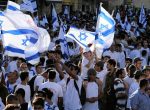Jerusalem Day celebrations in Israel (photo by Ashernet)
This Jerusalem Day – 28 Iyar (June 5) – marks 49 years since the city split in two by Jordanian occupation became reunited. Nowadays, the names of battle sites are just part of our everyday language – French Hill, Ammunition Hill, Government House – but back in 1967, these were the places where armies were pitted against each other in battle.
We didn’t have Ramat Eshkol then; the hilltops of Gilo were barren and windswept. The Israeli army fought to win territory to the north and the south, until only the walled Old City was still in Jordanian hands.
The war, not of our making, was sparked on April 7, 1967, when the Syrians opened fire on Israeli tractors working near Kibbutz Ha’On, east of the Kinneret. The Israel Defence Forces returned fire, so the Syrians began shelling settlements. Israel Air Force jets were sent to destroy Syria’s artillery batteries. Then Syrian MiGs were sent to intercept them, resulting in dogfights above Kibbutz Shamir. Eventually, six Syrian planes were downed and Syria demanded that Egypt issue a response, which posed a dilemma for president Gamal Abdel Nasser. To prod him, Syria said Israel was amassing forces on the northern border, which was untrue, but Nasser sent massive forces to Sinai on May 14 and 15.
Israel had to call up its reserves, as all United Nations troops had left the Sinai and Gaza. Volunteers swarmed to help with transportation, distributing food and preparing bomb shelters, helping in factories and kibbutzim. Thousands of our soldiers were deployed along the Egyptian border waiting for cabinet to make a decision.
There were frequent meetings between prime minister Levi Eshkol and chief-of-staff Yitzhak Rabin, who said that the IDF was strong and could repel any Arab attack. There were messages from U.S. president Lyndon Johnson calling – as is always the case! – for Israel to show restraint. Egypt also was asked not to escalate the situation.
Eshkol announced that Israel did not seek war, but to no avail. The Egyptians closed the Tiran Straits. On June 5, the war began. Two hundred IAF jets destroyed the entire air forces of Egypt, Syria and Jordan: 374 planes were destroyed on the ground and the rest in dogfights. Israel had complete aerial supremacy during the six days of battle.
On the ground, the IDF entered Sinai in three columns. Jordan started shelling Jerusalem, firing day and night, resulting in many casualties, while Syrian jets raided Haifa Bay and northern settlements.
On June 6, our paratroopers surrounded the Old City and, at 10 a.m. on June 7, they broke through the Lions’ Gate, liberating the Western Wall and the Temple Mount. Lt.-Gen. Motta Gur stood near the Wall, and announced on the radio: “The Temple Mount is in our hands!”
After hours of fierce battles, the paratroopers burst into tears. According to Mordechai Rechschafner, a volunteer from Australia, “There was no sense of jubilation. We had lost too many friends. We had paid for our victory with blood and sacrifice.” When Maj.-Gen. Shlomo Goren, the chief military rabbi, arrived at the Kotel, he blew the shofar and said a prayer: “This is the day we have been yearning for. Let us rejoice in it!”
The Six Day War ended two days later, after the Israel Navy conquered the Tiran Straits and seized Egyptian army bases and airfields in Sinai, and Israel captured the Syrian fortified posts. When the Golan Heights was conquered, the war ended.
There was both great euphoria and terrible sadness. Jerusalem was the focus of the greatest celebration, but a great toll had been exacted. All day the radio played Naomi Shemer’s “Jerusalem of Gold” – it became a victory anthem.
It was three years later that I arrived with my husband and four children in Jerusalem. Forty-six years have passed, and my love for the city has deepened every day. There have been hard times and there was heartache when each of our children served in the army. When our son was a paratrooper in Lebanon, we questioned whether we had made the right decision in bringing them from the safety of their birthplace Australia. Now, most of their children have served in the army or are soon to be inducted, but none of them has ever felt we made a wrong decision. They grew up in Jerusalem and know as we do that it is special. Our feet walk over the stones that King David danced on. We pray at the Western Wall where the Holy Presence, the Shekhinah, still lingers. We travel roads on which kings, soldiers, priests and other holy men have traveled for thousands of years, century after century. Every day, we bathe in the unique quality of golden light that artists have striven to capture.
Each neighborhood in Jerusalem is different. Quiet alleyways that meander, bustling markets filled with the color and spicy smells of the Middle East, walled courtyards softened with a glimpse of greenery. Holy sites where prayers are whispered and blessings invoked. Quiet hills silhouetted with pine trees. Graveyards for the old and military cemeteries for the young. Parks where children laugh and dimpled babies are wheeled in prams. So ancient, and yet also a modern metropolis where people work, play, shop, drive, argue and love.
This Jerusalem Day, as I have for more than four decades, I will thank G-d for the privilege of living here and pray for the peace of Jerusalem forevermore.
Dvora Waysman is a Jerusalem-based author. She can be contacted at dwaysman@gmail.com or via her blog, dvorawaysman.com.

